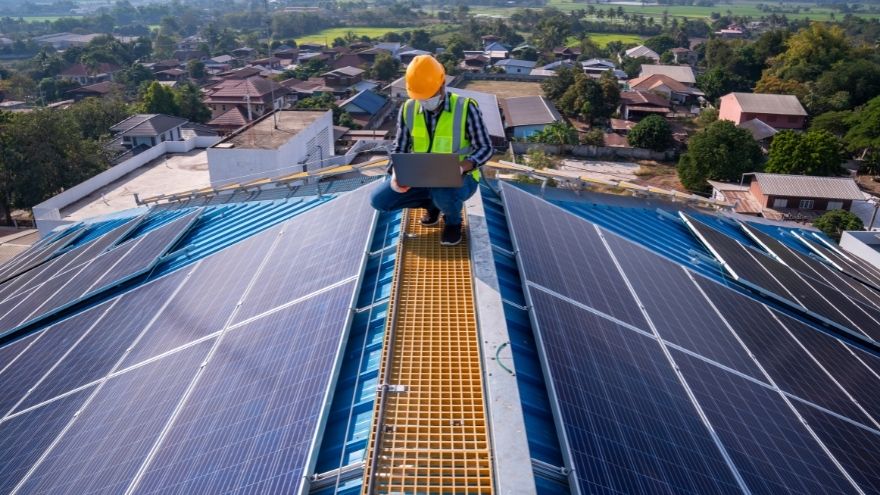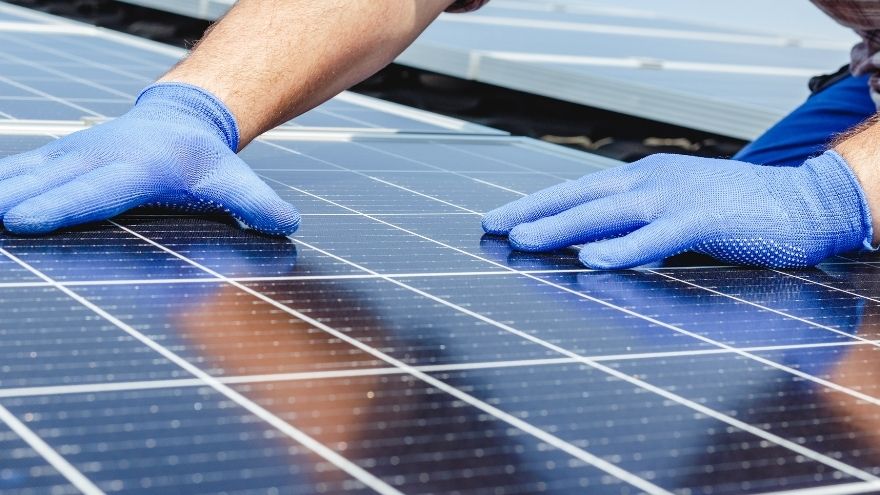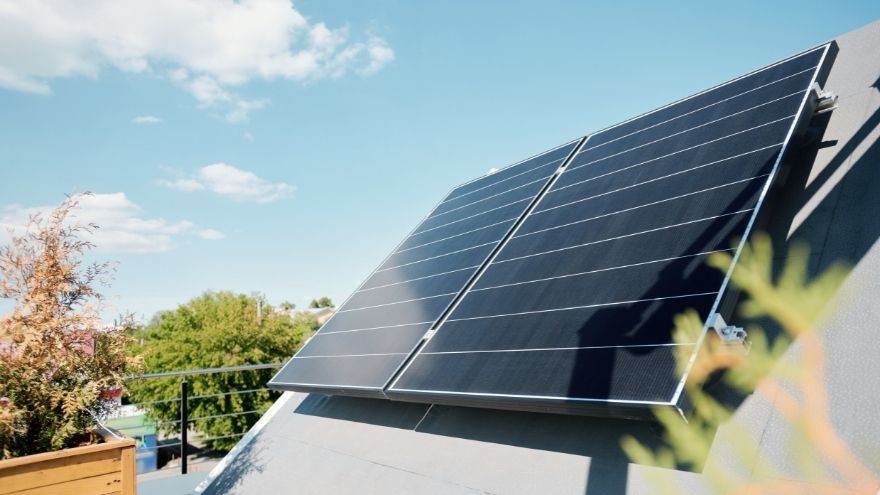Photovoltaic installations are an excellent way to reduce electricity bills and reduce emissions of harmful compounds into the atmosphere. More and more enterprises and housing cooperatives decide to install them, guided by economic aspects and the idea of corporate social responsibility. In order for photovoltaic panels to perform their role properly, you must ensure that they are properly positioned. We tell you what you need to know about installing PV modules!

From this article you will learn:
- who should install photovoltaic panels,
- what are the most important rules for installing photovoltaic panels,
- where photovoltaic modules can be installed.
Check out the offer of photovoltaic panels at the Onninen wholesaler
Who can install photovoltaic panels?
At the very beginning, it is worth noting that the law does not prohibit the installation of photovoltaic panels on your own , but in accordance with the provisions and regulations of the OSD, in order for the installation to be connected, it is necessary to have an electrical qualification, construction license or a UDT certificate.
When hiring an installer, it is worth making sure that he has:
- certificate of the installer of the Office of Technical Inspection,
- qualification certificate,
- construction licenses with installation specialization in the field of electrical networks and devices (SEP type D and E).
Pursuant to the Act, you are required to have at least one of the above-mentioned credentials . Information about the installer's authorizations is included in the connection application. Before entrusting work to a selected company, the investor should also verify its experience and completed projects.
How to properly install photovoltaic panels?
 A properly installed photovoltaic installation with a capacity of 1 kWp will produce approximately 1,000 kWh of electricity per year, which will translate into a reduction in carbon dioxide emissions by over 800 kg. It is also a way to reduce electricity bills by several dozen percent. Therefore, companies are eager to use solar panels and integrate them with modern devices such as heat pumps or recuperators, which guarantee even further savings.
A properly installed photovoltaic installation with a capacity of 1 kWp will produce approximately 1,000 kWh of electricity per year, which will translate into a reduction in carbon dioxide emissions by over 800 kg. It is also a way to reduce electricity bills by several dozen percent. Therefore, companies are eager to use solar panels and integrate them with modern devices such as heat pumps or recuperators, which guarantee even further savings.
In order for photovoltaic panels to actually provide your company with such benefits, you must ensure their proper location. What parameters should be taken into account?
- direction and angle of inclination of photovoltaic panels. Smaller angles, however, do not significantly affect the energy yield - for example, 20 degrees is up to 98% of the value that can be generated with an inclination of 35 degrees. For an east-west installation, the ideal angle is 0 degrees;
- shading of modules - when installing photovoltaics, you should avoid places that are regularly shaded. This will guarantee high efficiency of the entire system. Additionally, the shadow may lead to an unnatural increase in temperature in some cells;
- exposure of panels to wind - this is a parameter that, contrary to appearances, is worth paying attention to. Although gusts of wind do not have a direct impact on the efficiency of a PV installation, they can damage it. We are talking primarily about roof edges, where there is a high load caused by air movement. During installation, it is worth making sure that in the event of stronger wind, individual elements of the installation will not be lifted or detached;
- arrangement of modules relative to the roof - make sure that the photovoltaic panels do not protrude beyond the edge of the roof. Appropriate gaps should also appear between the modules themselves and under them. This will ensure controlled air movement, naturally cooling the system components and increasing their efficiency.
Knowing the basic rules regarding the installation of photovoltaic panels on the roof, you should also be interested in the rules applicable during installation works . Persons installing PV modules must bear in mind that:
- you must not stand, sit or place any objects on photovoltaic panels ,
- panels can only be placed on a fireproof surface with fire class A,
- damaged photovoltaic panels (front or back layer) must not be installed ,
- installation of photovoltaic panels should not be carried out in unfavorable weather conditions,
- A torque wrench should be used to install the panels to ensure optimal tightening of the screws.
Check out the full offer of photovoltaic panels
Installation of photovoltaics depending on the location and type of coverage
Although in Poland you most often see photovoltaic panels mounted on sloping roofs, there is nothing stopping you from placing them on a flat roof or on the ground. However, remember that in each of these cases, the installation work will look slightly different.
Installation of photovoltaic panels on a sloping roof
In such a situation, a supporting structure should be used, attached to the roof rafters. The mounting rails are only used to attach the panels, but not to ensure a specific angle of inclination, as this is determined by the curvature of the roof. The course of work will vary depending on the covering:
- surface covered with metal roof tiles - the challenge is primarily to locate the rafters to which the frame will be screwed. This is usually done by marking them from the attic side, removing the soffit, unscrewing the ridge or dismantling sheet metal. The mounting system usually includes rails, connectors, clamps, double-threaded screws, an adapter and additional screws and nuts. Screws with gaskets are installed in the holes made in the sheet metal. An adapter is installed on them - a connector for aluminum rails to which the panels are attached;
-
 surface covered with roof tiles - in this case the process is slightly more complicated. At the very beginning, you need to remove a few roof tiles to expose the rafters. Hooks are attached to them and the removed roof tiles are placed back in place. To prevent them from sticking out, they need to be sanded lightly. The rails are attached to the mounted brackets, and the photovoltaic panels are attached to them using clamps. The installer should arrange them from the edges to the center;
surface covered with roof tiles - in this case the process is slightly more complicated. At the very beginning, you need to remove a few roof tiles to expose the rafters. Hooks are attached to them and the removed roof tiles are placed back in place. To prevent them from sticking out, they need to be sanded lightly. The rails are attached to the mounted brackets, and the photovoltaic panels are attached to them using clamps. The installer should arrange them from the edges to the center; - trapezoidal sheet - installing photovoltaic panels on trapezoidal sheet is not complicated. The assembly system dedicated to trapezoidal sheet metal consists of high (60 mm) and low (21 mm) trapezoidal bridges, middle and end clamps, self-tapping screws, nuts, Allen screws and washers. To obtain better air circulation between photovoltaic panels, higher trapezoidal bridges should be used. Installation of panels on trapezoidal sheet metal should begin with marking the points where the bridges will be attached. The rails are attached to the sheet metal using sheet metal screws, screwing them into the hump at the top. The next step is to arrange the panels. The first one is installed using the end clamp, and then the middle clamps are installed one by one without tightening them. The module should be screwed together using previously prepared clamps on which the panels were placed. The last module is attached using an end clamp;
- seam sheet - mounting photovoltaic panels on seam sheet is a popular solution because it reduces energy consumption and provides a cooling effect. All thanks to the fact that the hem is made of metal. The assembly itself is also quite easy and quick. Clamps are placed directly on the hem and then attached to the side with a screw. The rail is then mounted on the clamp using a T-head screw and an angle connector.
Installation of photovoltaic panels on a flat roof
To mount photovoltaic panels on a flat roof, use, for example:
- ballast system – aluminum frames weighted with concrete blocks. This solution is easy to implement and does not require perforating the roof;
- assembly system without ballast - the axis of the structure is an aluminum support frame, attached to concrete blocks on the roof. This popular method also does not require any interference with the sheathing;
- anchored system – a structure permanently attached to the surface (e.g. reinforced concrete roof). The assembly process should be carried out before the building is insulated;
- structure glued to the roof surface, roofing felt or membrane - the main advantage of such systems is the lack of interference with the roof covering and low surface load.
Installation of photovoltaic panels on the ground
Installing a photovoltaic installation on the ground requires prior analysis of the shading and compactness of the substrate. Based on this last parameter, the appropriate method of installing the supporting structure is selected. The actual work is divided into two stages:
- Setting up the structure for photovoltaic panels - usually frames made of reinforced, galvanized steel, resistant to difficult weather conditions. Most often, they are covered with a Magnelis coating. The most popular installation system is a piled structure (driven into the ground). They are also mounted on a concrete base or screwed into the ground.
- Device installation – installation of panels, inverter and cabling. To avoid unnecessary losses, the inverter can be mounted as close to the other elements as possible. Electrical cables should be about 50-100 cm underground, and the panels should be at least 60 cm above the ground (they will not be shaded by plants).
You can find photovoltaic panels at the Onninen wholesaler!
If you are planning an investment in photovoltaics, check out the assortment of our online wholesaler. Efficient solar panels from leading manufacturers are waiting for you here. The most popular choices include:
Choose the devices that best suit the needs of your company and start saving on electricity !
